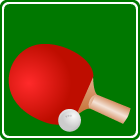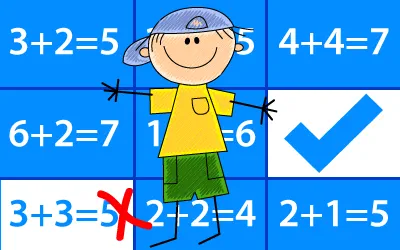


Game: FOUR IN A ROW
Aim: To get four symbols in a row
Method:
Choose a square and click on it. Click on the correct answer to the question in the box that appears. If you are right the square is replaced by a tick. Continue until you have won 4 in a row...

anonymous 😍😍😍
"Identify polygons, quadrilaterals"
4 IN A ROW game to practice
'Fractions of amounts' for 6th grade
6th grade / Number / Fractions / Multiply fractions / Fractions of amounts
Calculate fractions of amounts
Calculating fractions of amounts involves finding a fraction of a given quantity or number. The process of calculating fractions of amounts can be done in two ways.
Method 1: Divide the number or quantity by the denominator of the fraction, then multiply the result by the fraction numerator to get the answer.
This method can be summarised as:
fraction of amount = (amount ÷ denominator) x numerator
Method 2: Convert the fraction to a decimal then multiply that decimal by the quantity or amount. Follow the steps below to see how this method works:
Step 1: Convert the fraction to a decimal
The first step in calculating fractions of amounts is to convert the fraction to a decimal. To do this, you need to divide the numerator by the denominator. For example, if you want to calculate 1/4 of 80, you would divide 1 by 4, which gives 0.25.
Step 2: Multiply the decimal by the quantity
Once you have converted the fraction to a decimal, the next step is to multiply the decimal by the quantity you are trying to find the fraction of. For example, to find 1/4 of 80, you would multiply 0.25 by 80, which gives you the answer of 20.
So, the general formula to calculate fractions of amounts with this method is:
fraction of amount = (numerator ÷ denominator) x amount
For example, to calculate 3/5 of 100, you would follow these steps:
Step 1: Convert the fraction to a decimal
3 ÷ 5 = 0.6
Step 2: Multiply the decimal by the quantity
0.6 x 100 = 60
Therefore, 3/5 of 100 is 60.
With our Four in a row math game you will be practicing the topic "Fractions of amounts" from 6th grade / Number / Fractions / Fractions. The math in this game consists of 16 questions that ask you to find fractions of amounts by first dividing by the fraction denominator then multiplying by the numerator.
6th grade : Fractions
Sections
5 sub categories:
- Fraction basics
- Add fractions
- Subtract fractions
- Multiply fractions
- Divide fractions
In Year 7 in the UK, students typically continue to build upon their understanding of fractions, which they started developing in earlier grades. Here's an overview of key concepts related to fractions that are commonly taught in Year 7:
Understanding Fractions: Students learn that fractions represent parts of a whole or a group. They understand that a fraction consists of a numerator (the number above the fraction line) and a denominator (the number below the fraction line). The numerator represents the number of parts being considered, while the denominator represents the total number of equal parts that make up a whole.
Equivalent Fractions: Students explore equivalent fractions, which are different fractions that represent the same value. They learn that equivalent fractions can be obtained by multiplying or dividing both the numerator and the denominator by the same number. For example, 1/2 is equivalent to 2/4, 3/6, and so on.
Comparing and Ordering Fractions: Students learn to compare fractions and order them from least to greatest or greatest to least. They understand that when fractions have the same denominator, the one with the larger numerator is greater. When fractions have different denominators, they convert them to equivalent fractions with a common denominator to compare.
Adding and Subtracting Fractions: Students begin to add and subtract fractions with the same denominator (for example, 1/4 + 2/4). They also learn to add or subtract fractions with different denominators by finding a common denominator and then adjusting the numerators accordingly.
Multiplying and Dividing Fractions: Students explore multiplication and division of fractions. They learn to multiply fractions by multiplying the numerators together and the denominators together. For division, they learn to invert the second fraction and multiply. For example, to divide 1/4 by 1/2, you multiply by the reciprocal, which is 2/1.
Fractions in Real-Life Contexts: Students apply their understanding of fractions to real-life situations, such as measurements, recipes, and problem-solving scenarios. They learn to interpret and solve word problems involving fractions.

The game will reinforce the math you have chosen to learn by getting you to match the question to the correct answer.
Notes
- Do the Math lessons for your topic before playing this game
- Wrong answers are ok, you just have to try again until you get them right
- There is help available for all games by clicking the question mark button
UXO * Duck shoot * The frog flies * Pong * Cat and mouse * The beetle and the bee
Rock fall * Four in a row * Sow grow * Choose or lose * Mix and match





How to play 4 in a row to practice
'Fractions of amounts' for 6th grade

- Select "4 in a row" on the math games selection page.
- Take a quick look at the method text for 4 in a row.
- Click on PLAY to proceed, or change your topic with the CHANGE TOPIC button.
- On the play page you have a grid of 16 pictures (some topic picture are shown multiple times for shorter topics).
- Click on a picture cell.
- The topic question will appear along with a series of possible answers.
- Click the speaker icon to hear any particular answer (Speech enabled browsers only).
- Click the answer that corresponds to the picture question.
- If you are correct, the picture will be replaced by a tick - otherwise, a wrong sound will play.
- Continue matching picture questions to their correct answers until you have completed a line of 4 cells.
- The line can be diagonal as well as horizontal or vertical.
- 4 ticks in a row wins the game.
- Choose an option from the green sign, or click on games to choose a different game.










